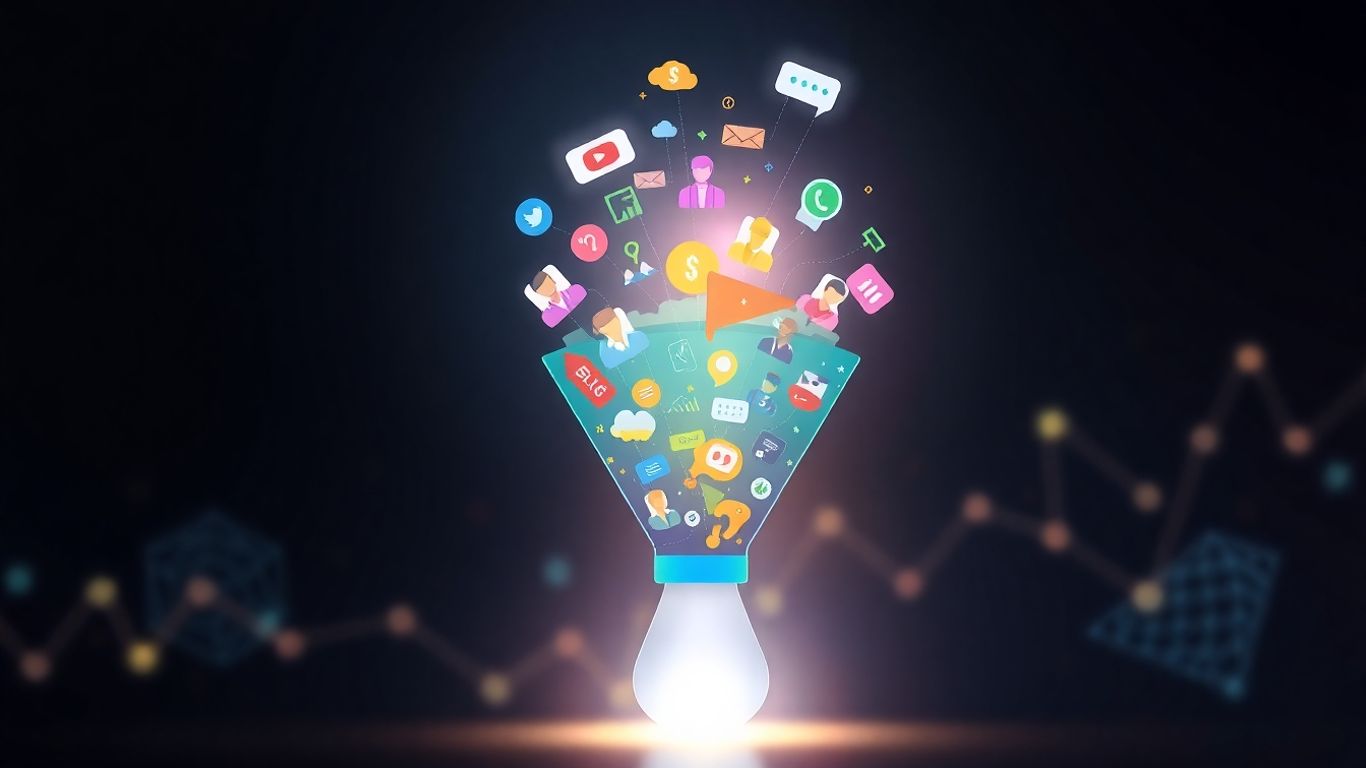
Understanding Ad Fatigue: Causes, Symptoms, and Solutions
Learn what is ad fatigue, its causes, symptoms, and effective solutions to combat it and keep your ad campaigns engaging and performing well.

Getting new customers is a big deal for any business, right? It doesn't matter if you're a sales team trying to keep your pipeline full or a marketing company aiming for real results. Getting good at finding potential customers, or leads, can really make you stand out. So, what is this lead generation thing, and why is it so important? Basically, it's the process of finding people who might be interested in what you offer and turning them into people who could become customers. These leads are the folks who might buy from you later. Without them, your sales and marketing efforts would just stop. In this guide, we'll walk you through the whole lead generation process, step by step. We'll cover how to get people interested, collect their info, and then keep them engaged until they're ready to buy. We'll share tips, strategies, and tools to help you do better, with a special look at how certain tools can change how you find and connect with people who might buy from you. Ready to get better at finding leads? Let's get started.

Alright, let's talk about lead generation in 2025. It's not quite like it was a few years ago, is it? Things are always shifting, and staying on top of it can feel like a full-time job. The main goal is still the same: finding people who might want what you're selling and getting them interested. But how we do that is changing, fast.
Look, if you're not bringing in new potential customers, your business isn't going anywhere. That's just a fact. In 2025, lead generation is more important than ever because the market is crowded. You need a steady stream of interested people, or "leads," to keep your sales team busy and your revenue growing. It's the engine that powers everything else. Without good leads, even the best product or service will just sit there.
This is a big one. We've got all this amazing AI now that can do so much for us, like sorting through data or sending out initial emails. It's great for efficiency, no doubt. But here's the thing: people still want to talk to people. Too much automation can feel cold and impersonal, and that's a quick way to lose someone's interest. The trick for 2025 is finding that sweet spot. Use AI to handle the repetitive stuff, freeing up your team to have those real conversations, build relationships, and actually connect with potential customers. It’s about working smarter, not just faster.
The challenge is to make technology serve human connection, not replace it. AI can identify patterns and automate outreach, but it can't replicate genuine empathy or build trust in the same way a person can. The most successful strategies will be those that blend the efficiency of machines with the irreplaceable value of human interaction.
So, what does a lead generation workflow actually look like these days? It's basically the step-by-step plan your team follows. It starts with figuring out who you're even trying to reach. Then, you need ways to get their attention, like through good content or ads. After that, you need to capture their information, maybe with a form on a landing page. Then comes the nurturing part, where you keep them engaged until they're ready to buy. Finally, you hand them off to sales.
Here’s a simplified look at the stages:
Having a clear workflow helps everyone on the team know their role and what to expect. It makes the whole process smoother and less chaotic. For businesses looking to maximize their lead generation efforts, combining these approaches offers the best of both worlds: the engagement power of traditional methods and the efficiency of modern technology. You can find more about effective B2B lead generation in 2025 here.

So, you've got a website, maybe some great content, but how do you actually get people to notice it and, more importantly, give you their information? It's like having a store but no one knows it's there. We need to get folks in the door and then make it easy for them to say, 'Hey, I'm interested!' This part is all about making your business visible and giving people a reason to connect.
Think of content marketing and SEO as your digital storefront and signage. You want people searching for solutions to find you, right? That's where SEO comes in. It's about making sure when someone types "how to fix a leaky faucet" into Google, your helpful blog post about plumbing pops up. High-quality content, like guides, articles, or even short videos that genuinely help people, is the magnet. It answers their questions and shows you know your stuff. When people find your content useful, they're more likely to stick around and explore what else you have to offer. It's not just about getting clicks; it's about attracting the right people who are actually looking for what you do.
Okay, so someone found your awesome content. Now what? This is where your calls-to-action (CTAs) and landing pages become super important. A CTA is basically a prompt – like a button or a link that says "Download Our Free Guide" or "Sign Up for a Demo." It needs to be clear and tell people exactly what they'll get. Your landing page is where they go after clicking that CTA. It should be focused, easy to understand, and have a simple form to fill out. The goal is to make it as easy as possible for someone to take that next step. Don't ask for their life story on the form; just get the basics like their name and email. If the page is cluttered or the form is too long, people will just leave. We want them to feel like they're getting a good deal for their information.
This is where things get a bit more advanced, but it's really useful. You know how some people visit your site, browse around, but never fill out a form or click a CTA? They're like window shoppers who walk away without buying anything. There are tools out there that can help you identify these anonymous visitors. They can tell you which companies are visiting your site, what pages they looked at, and what they seemed interested in. Knowing this information means you can then reach out to them directly, maybe with a personalized email or a targeted ad, saying something like, "Hey, we saw you were checking out our services page. Can we help?" It's a way to turn those curious browsers into potential leads without them having to raise their hand first.
Capturing leads isn't just about getting names and emails. It's about understanding who is interested in what you offer, even if they don't explicitly tell you. By making your content discoverable and your offers clear, you invite people in. Then, by using smart tools and clear next steps, you can turn those visitors into valuable connections for your business.
So, you've managed to get someone interested enough to give you their contact info. Awesome! But that's just the start, right? Now comes the real work: figuring out who's actually a good fit and gently guiding them towards becoming a customer. It's easy to get excited and send every single person straight to sales, but honestly, that's usually a bad move. Most of the time, leads aren't ready to buy the second they land on your site or download your ebook.
This is where you build relationships over time. Think of it like getting to know someone before asking them out. You send a series of emails that aren't just sales pitches. They offer more helpful info, answer common questions, and show off how your product or service solves problems. The goal is to stay top-of-mind and build trust without being annoying.
Not all leads are created equal, and lead scoring helps you figure that out. You assign points based on actions a lead takes. Did they visit your pricing page? That's worth more points than just reading a blog post. Did they open every email? More points. This way, your sales team knows which leads are hot and which ones still need a bit more marketing attention.
Here's a quick look at how points might add up:
The trick here is to work with your sales team to define what really matters. What actions do their best customers take before buying? Use that info to build your scoring system. It's not about guessing; it's about using data to guide your efforts.
Once you know who's interested and why, you can tailor your communication. Generic emails get ignored. But if you know someone is struggling with a specific problem, and you have a solution for it, mentioning that directly makes a huge difference. It shows you've been paying attention and actually care about helping them, not just making a sale. Personalization is key to making leads feel seen and understood. This could mean mentioning their company name, referencing a specific challenge they might be facing, or suggesting a product feature that directly addresses their needs. It's about making that connection feel human and relevant.
So, you've got the basics down, but how do you really build a lead generation machine that keeps on giving? It's not just about throwing things at the wall and seeing what sticks. You need a plan, and that means understanding the different ways you can go about it. Think of it like building a house – you need the right tools and techniques for each stage.
When we talk about getting leads, there are two main paths: inbound and outbound. Inbound is like setting up a really attractive shop that people naturally wander into because they're looking for what you have. Outbound is more like going out and knocking on doors to see if anyone needs what you're selling. Both have their place, and often, using a mix of both is the smartest move.
These days, you can't ignore social media and paid ads. They're powerful tools if you use them right. It’s not just about posting randomly; it’s about being strategic.
It's easy to get caught up in the numbers and the clicks, but remember that behind every lead is a person. They have their own problems and needs. Your goal is to connect with them in a way that feels helpful, not just transactional. Building that connection is what turns a casual visitor into a loyal customer.
Static content is fine, but interactive content? That’s where the magic happens. It gets people involved and gives you more information about them.
It’s easy for marketing and sales teams to end up working in different directions. Marketing might be focused on getting as many names as possible into the system, while sales might feel like they're getting a bunch of people who aren't really ready to buy. This disconnect means leads can get lost, and everyone ends up frustrated. The real win happens when these two teams work together like a well-oiled machine.
Think about it: marketing finds potential customers and gets them interested. Sales then takes those interested folks and turns them into actual customers. If they don't talk to each other, marketing might not know what kind of leads sales actually needs, and sales might not understand what marketing is doing to bring people in. That's why getting everyone on the same page is so important.
Here’s how to get started:
Once marketing hands a lead over to sales, the conversation shouldn't stop. Sales needs to tell marketing what they're hearing from these leads. Are they a good fit? What are their main questions or concerns? This information is gold.
This back-and-forth helps marketing adjust its messaging and targeting. If sales keeps saying leads are asking about a specific feature, marketing can create more content around that feature. It’s a continuous improvement cycle.
Here’s a simple way to set this up:
What gets measured gets managed. But if marketing and sales are looking at different numbers, they'll never truly be aligned. It’s better to focus on metrics that show the overall health of the business, not just departmental wins.
Consider these metrics that both teams can influence:
By focusing on these shared numbers, marketing and sales can see how their individual efforts contribute to the bigger picture, making them more likely to collaborate effectively and drive better results for the entire company.
So, you've put in the work to attract and capture leads. That's great! But the job isn't done. To really get good at this, you've got to look at what's working and what's not. It’s like tweaking a recipe – you taste it, adjust the spices, and try again. The same goes for bringing in new potential customers.
This is where you roll up your sleeves and look at the numbers. You need to see which campaigns are actually bringing in people who might buy something. Are your ads on social media doing better than your blog posts? Is that new ebook download actually leading to sales conversations?
Here's a quick look at some key things to track:
Sometimes, numbers only tell part of the story. Heatmaps are pretty cool tools that show you where people are clicking, scrolling, and spending time on your website. It's like watching someone use your site without them knowing. You can see if people are missing your important buttons or if they're getting stuck on a certain page. This visual feedback can point out problems you wouldn't find just by looking at analytics.
Understanding how users interact with your digital presence is key. If they're not seeing your calls-to-action or if they're bouncing off pages quickly, something needs to change. These tools help pinpoint those friction points.
Lead generation isn't a 'set it and forget it' kind of thing. The market changes, people's habits change, and you need to change with them. This means constantly trying new things and seeing what happens. Maybe you try a different headline on your ad, change the color of a button on your landing page, or test out a new type of email subject line. Small changes can sometimes make a big difference. Keep track of these tests and learn from them. It’s all about making your process better over time, one small adjustment at a time.
So, we've walked through how to build a solid lead generation plan for 2025. It's not just about throwing things at the wall to see what sticks, you know? It's about really understanding who you're trying to reach and then using the right tools, whether that's smart tech or just good old-fashioned talking to people, to connect with them. Remember, leads are people first, so treat them that way. Keep testing what works, stay flexible, and don't be afraid to try new things. By mixing smart automation with that personal touch, you'll be well on your way to filling your pipeline with folks who actually want to do business with you.
The main goal is to find people who might be interested in what you're selling and get them to show that interest. It's like finding potential customers and getting them excited enough to learn more, so your sales team can talk to them.
AI can help by doing a lot of the repetitive work, like sorting through lists of people or sending initial emails. This frees up your team to focus on building real connections with the most promising leads.
While AI is super fast, people still want to feel like they're talking to a real person. Using AI for the busy work and having humans handle the important conversations helps build trust and makes people more likely to buy.
Inbound is like setting a great store window display that naturally draws people in. Outbound is more like going out and talking to people directly to see if they're interested. Both can work!
You can use something called 'lead scoring.' This is like giving points to leads based on how interested they seem (like visiting your pricing page) and how well they fit what you're looking for. The ones with the most points are usually the best to focus on.
You need to 'nurture' them. This means sending them helpful information over time, like emails or useful articles, that keep them interested and help them learn more about how you can solve their problems. It's about building a relationship.